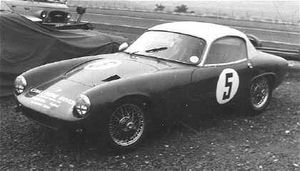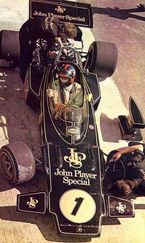.
Lotus Elite
Error creating thumbnail: Unable to save thumbnail to destination
| |
| Lotus Elite | |
|---|---|
| Lotus | |
| aka | Type aka here, not up there |
| Production | 1957-1962 1000 units 2014-present |
| Class | Sports Car, GT |
| Body Style | 2-Door, 2+2-seat Convertible+Coupe |
| Length | 181.10 in |
| Width | 74.80 in |
| Height | 51.97 in |
| Wheelbase | wheelbase - type here |
| Weight | 3600 lb (1650 kg) |
| Transmission | 7-speed Dual-Clutch, RWD |
| Engine | 5.0 litre Lexus IS-F V8 |
| Power | 542 hp (611 R-Tuned) @ N/A rpm 530 lb-ft of torque @ N/A rpm |
| Similar | similar (competition) |
| Designer | Peter Kirwin-Taylor and Frank Costin |
The Lotus Elite name was used for three vehicles from Lotus. The first Elite or Lotus Type 14 was an ultra-light two-seater coupé, produced from 1957 to 1962. In 2014, the nomenclature has been revived again in the form of a 600hp retractable hardtop Grand Tourer.
See Wikicars' comprehensive Lotus Elite Review.
Recent Changes
- The 2010 Paris Motor Show is playing host to the debut of the third-generation MY2014 Lotus Elite. Now wearing a 2+2 Grand Tourer body, 3600 lb car packs a 5.0 litre V8 producing 542 hp and 530 lb-ft of torque (611 hp in the R-tuned version) mated to a 7-speed dual-clutch transmission. This allows it to blast its way to 60 mph in 3.6 seconds and top out at 315 km/h (196 mph). Plans are in the works to offer it as a hybrid with emissions as low as 215 g/km and featuring technologies such as a hybrid gearbox (with integrated electric motors) and a Kinetic Energy Recovery System (KERS). The car is set to go on sale in spring of 2014 with a base price of £115,000 (including a VAT of 17.5%)[1][2]
Styles and Major Options
Certain vehicles come in different trim levels or body styles. Features and major options should be mentioned here.
Pricing
Add more fields as necessary.
| MODEL Trims | |||
|---|---|---|---|
| Trim1 | Trim2 | Trim3 | Trim4 |
| MSRP | |||
| $Price1 | $Price2 | $Price3 | $Price4 |
| Invoice | |||
| $Price1 | $Price2 | $Price3 | $Price4 |
Gas Mileage
Add more fields as necessary.
As seen on the FuelEconomy.gov website, the City/Highway MPG averages are as follows:
| Trim | |||
|---|---|---|---|
| Trim1 | Trim2 | Trim3 | Trim4 |
| MPG | |||
| c/h | c/h | c/h | c/h |
Engine and Transmission
Specifications, details, graphs, pictures and other information regarding the powertrain is placed in this section.
Performance
Please make sure to write information of the vehicle's performance in a third-person point of view. This section should include information about the car's acceleration figures, handling, braking, etc.
If using information gathered from Road Test articles from a reputable automotive source, then please make sure to cite the quote.
Reliability
Warranty options and scheduled maintenance information should be mentioned here.
Safety
This section should reference points on safety ratings and features of the vehicle.
Photos
Add Photos of the vehicle here.
Please make sure not to use copyrighted photos.
Colors
List the colors that the particular <MODEL> is offered in.
Main Competitors
Create links to other <MAKE> <MODEL> pages in this section.
Hybrid Models
If there are hybrid versions of this vehicle manufactured, then please elaborate a little bit on it here.
Unique Attributes
If there are any features of this vehicle that sets it apart from other vehicles in its class, then mention those unique attributes here.
Interior
This section should include information on the interior's design, build quality, ergonomics, space (head and legroom, front and rear), features, stowage compartments and overall comfort and livability. Add pictures wherever applicable and keep information in a third-person point of view.
Resale Values
Add more fields as necessary.
| <MODEL> Year | |||
|---|---|---|---|
| Year X | Year X-2 | Year X-3 | Year X-4 |
| Resale Value | |||
| $ | $ | $ | $ |
Criticisms
Please make sure to keep critiques in a third-person point of view. If using criticisms from a reputable automotive source, then please make sure to cite the quote.
Generations
Fill in as many as appropriate. Add more if necessary and pictures wherever applicable.
Please make sure NOT to use copyrighted pictures.
Current Generation: (2014–present)
This article is a stub. Help us expand it, and you get a cookie.
Second Generation (1974-1982)
From 1974 to 1982, Lotus produced the considerably larger Type 75 and later the Type 83 4-seat Elite II. Lotus's first saloon car was front engined with rear wheel drive. Like all production Lotuses, the Elite II used fiberglass for the bodyshell mounted on a steel backbone chassis evolved from the Lotus Elan and Lotus Europa. It had a 4-wheel independent suspension and used Lotus's all-new 907 4-valve DOHC aluminium engine, which would have been the first 4-valve per cylinder, 2.0 L production engine had the Triumph Dolomite Sprint not been introduced the year before. In both naturally-aspirated and turbocharged versions the engine was the foundation for the Lotus Esprit powerplants. The Elite II was the basis for the Lotus Eclat, and later the Lotus Excel four seaters.
Correction: The Lotus 907 engine was first used in 1972 as the power-plant for the Jensen-Healey, and its use pre-dates Triumph's Dolomite.
"Like all production Lotuses since the Elan, the Elite II used fiberglass for the bodyshell, mounted on a steel backbone chassis"
First Generation/Origins (1957-1962)
The Elite's most distinctive feature was its highly innovative fiberglass monocoque construction, in which a stressed-skin unibody replaced the previously separate chassis and body components. Unlike the contemporaneous Chevrolet Corvette, which used fiberglass for only exterior bodywork, the Elite also used this glass-reinforced plastic material for the entire load-bearing structure of the car, though the front of the monocoque incorporated a steel subframe supporting the engine and front suspension.
The resultant body was both lighter, stiffer, and provided better driver protection in the event of a crash. The weight savings allowed the Elite to achieve sports car performance from a 75 hp (55 kW) 1216 cc Coventry Climax all-aluminium I4 engine. Climax-powered Elites won the "Index of Performance" six times at the 24 hour Le Mans race and many other races worldwide. The Elite was the first Lotus produced car to race in Australia and the original car to be raced in Australia is currently in boxes under re-furbishment.
Advanced aerodynamics also made a contribution, giving the car a very low drag coefficient of 0.29 — quite low even for modern cars. This accomplishment is all the more notable considering that the engineers did not enjoy the benefits of computer-aided design and wind tunnel testing. The original Elite drawings were by Peter Kirwin-Taylor. Frank Costin, (brother of Mike Costin, one of the co-founders of Cosworth), at that time Chief Aerodynamic Engineer for the DeHaviland Aircraft Company, contributed to the final design.
Just over 1,000 Elites were built.
Dimensions
- Length: 3708 mm
- Width: 1506 mm
- Height: 1181 mm
- Weight: 503.5 kg
- Transmission: 4-Speed Manual
- Engine: 1.2 litre Coventry Climax Inline-4
- Power: 75 hp (55 kW)
Worldwide
If the vehicle is sold in other markets worldwide, then this is the section to mention that information. Also, mention if the <MODEL> goes by another name in these other markets.
Design quirks and oddities
Refer to any pop-culture tidbits about the vehicle in this section.
Awards
List out notable awards that the model has received while in production. Boldface the company or organization that gives out the award, and Italicize the name of the award.
See Also
This article use content from Wikipedia Lotus Elite page with these contributors.
External Links
Please include any external sites that were used in collaborating this data, including manufacturer sites, in this section.
News and References
Enthusiast Sites and Discussion Forums






